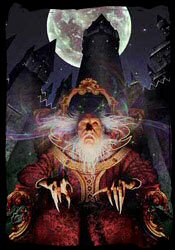|
PREVIOUS
NEXT
Nightdreamers
MAY 2002



Nightdreamers
is the third in Telos’ range of Doctor Who novellas, and the first
real failure. Its
author, Tom Arden, is most famous for his five-volume fantasy series
The Orokon, an epic of over a million words. He is, apparently, a big
fan of seventies Who. He cannot, however, claim to be able to write it.
Nightdreamers
is a science fiction take on Shakespeare’s classic A Midsummer Night’s
Dream. Nothing especially original there, but nothing wrong either.
However, it’s incredibly dull and dreary. There are some interesting
ideas: it is set on the moon Verd, which orbits a planet named Galaxis
Bright, under economic domination by its sister world Galaxis Dark. An
interesting set-up, but one that isn’t developed well. Verd has variable
gravity across its surface; there’s potential for a fascinating bit of
high-concept science fiction there, but sadly it goes unexplored. Verd
has a quasi-mediaeval society, one which is beset by the titular Nightdreamers
(read
‘elves’ or ‘fairies’); creatures that delight in mischief and trickery of a most
unoriginal kind.
 The
society of Verd is just painfully dull. Arden’s prose isn’t The
society of Verd is just painfully dull. Arden’s prose isn’t
astonishing,
but it’s his dialogue that makes this one hard to
stomach. Poncy romance novel
characters with names like
Tonio and Peterkin deliver drivel like
“Cursed, cursed be this wretched moon!” and “I weary of this
worldly folly”. The thought
extracts are even worse.
“Tonio, Tonio! Oh, Galaxis Bright,
Galaxis Bright!” Arden seems to think
that repeated words
signifies powerful emotions. Rather, it just irritates. The Doctor
and Jo are just as bad. The Doctor
really lacks character, and
is dropped into a story into which he doesn’t fit, while Jo spends
her
whole time wibbling on about that Thal she fancied in Planet
of the
Daleks, something that everyone apart from Arden would sooner
forget about, and probably had.
The
Nightdreamers themselves might as well be elves. The puck figure, Sly,
performs precisely the same sort of deeds as in the original play, talking
in poorly written verse as
he goes along. It all turns out that the
dreaded Nightdreamer King is a Norebo Worm (an anagram of Oberon, you
see), a larval creature that is altering gravity as it nests within the
moon, incubating prior to its hatching as a huge space moth. By the time
this is revealed,
I’d long lost
interest in the plot.
The only
interesting or entertaining part of Nightdreamers is Katy Manning’s
very humorous foreword. Another million words from this guy? I think I’ll pass.

|